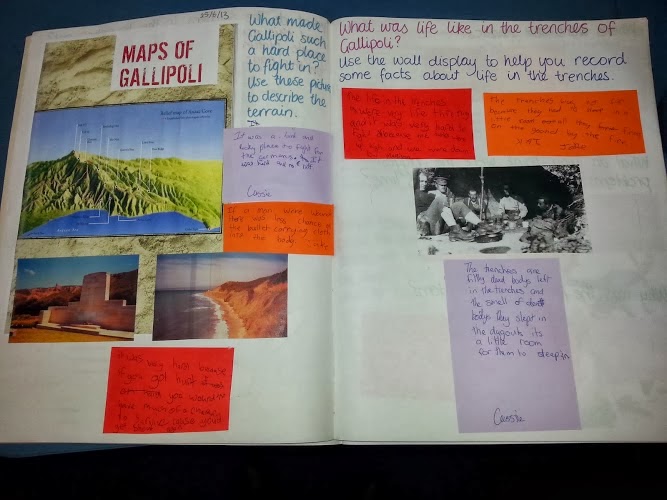Anyone who has delved into this blog before may have noticed that I have one or two posts about what I have taught or done with my class for Anzac Day. (See the label list on the side to find other Anzac Day posts).
This year Anzac Day falls right in the middle of the term break (again) in New Zealand. Yesterday I went shopping. I had seen the book shop brochures and the Scholastic Book Club, so I had a fair idea what this year's crop of new books on Anzac Day were... and I couldn't resist.
First up is a picture book, Jim's Letters, by Glyn Harper (the Massey University professor who also wrote The Donkey Man) and illustrated by Jenny Cooper.
What a beautifully illustrated and presented book. The premise is simple: two brothers, one off to Gallipoli, the younger at home on the farm with the family, writing letters to each other. The narrative simply states who sent the letter from where and when. The rest of the story is told through the letters themselves: postcards, letters (some which have to be lifted open or taken out of an envelope), one on a scrap of cardboard.
It is a gorgeous hard back book, but not one I'll be letting my class have willy-nilly with the pull outs and lift ups that could easily be ripped or lost. I will be setting some clear parameters around how this book will be shared.
At the end of the book it talks about "boy soldiers" - the soldiers who were under age, some as young as 14, who fought, died and survived Gallipoli. This will be an interesting avenue of learning to take with the class.
The next book is The Anzac Puppy by Peter Millett and Trish Bowles. This is a paperback picture book.
Again, a beautifully illustrated book. It continues on with a theme well worn now in children's war picture books of animals at war. The premise is that a little girl gets a puppy called Freda, a New Zealand soldier comes along and likes the dog so takes her to the Western Front as the mascot for the company. The young soldier takes solace in the dog as his friends are killed or felled by sickness. And I'm not going to tell you the rest because it will spoil it for you.
Apparently there was a dog called Freda with New Zealand troops on the Western Front, and that dog has inspired this story, although this is a fictitious story. At the end of the story there is an explanation about what is now known about the real Freda and the soldiers she was with.
The third book is another paperback picture book, Best Mates, by Philippa Werry and Bob Kerr. Many teachers and students will know Philippa's work with the School Journal and Connected series, while Bob Kerr is most famous for his illustration in Terry and the Gunrunners and After the War.
This story introduces the reader to three best mates, the narrator and his mates Harry and Joe, who grew up together on the same street and went to school together. Then they signed up to go to war together. It goes on to explain how they went to Gallipoli, what happened there, what happened after the war and a return to Gallipoli years later. I won't spoil the rest.
Again, at the end of the story, there is some additional information about where Gallipoli is, how our troops got there, what it was like, how we remember those who fell, and some websites to visit.
This book I have not read yet (I've only had it 27 hours at the time of writing). This is David Hill's latest book Brave Company. David Hill's book My Brother's War was the focus of my last blog.
This book is about sixteen-year-old Boy Seaman Russell Purchas who is stationed on HMNZS Taupo in 1951 going into the Korean conflict.
I'm very excited about this book because most New Zealand war literature for children focuses on World Wars one and two, and there is very little on any later wars and conflicts we have sent children to. Also, there is very little for children on our own New Zealand wars in the mid 19th century (hint, hint writers).
Now, I probably won't read it to my class, but I intend on reading it myself and then "selling" the book to the class by reading a teaser page, and then hopefully one of my more confident readers will take it on to read. I'm picking this will be another great book to get boys reading, but I only have girls that will pick it up at the moment.

























